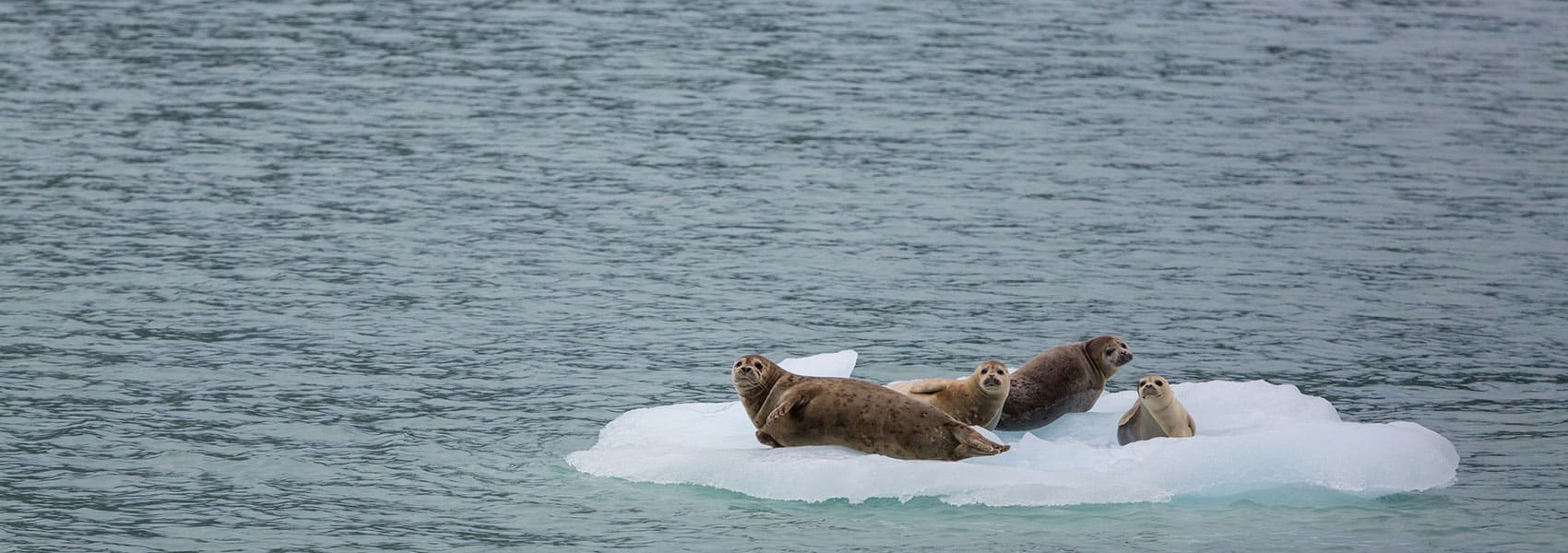Seasonal Movements, Habitat Selection, Foraging and Haul-out Behavior of Adult Bearded Seals in the Chukchi Sea
Background
Bearded seals ( Erignathus barbatus ) are one of the most important subsistence resources for the indigenous people of coastal northern and western Alaska, as well as key components of Arctic marine ecosystems, yet relatively little about their abundance, seasonal distribution, migrations, or foraging behaviors has been documented scientifically. Ice-associated seal populations may be negatively impacted by offshore oil and gas development as well as by climate change. Our ability to predict impacts, however, is limited by inadequate knowledge of seal population structure and foraging ecology.
Building on the successful ringed seal and young bearded seal capture and tagging models cooperatively developed between the Native Village of Kotzebue (NVOK), Alaska Department of Fish & Game (ADF&G), University of Alaska Fairbanks (Kathy Frost) and the National Marine Mammal Laboratory (NMML), the NMML, operating under a grant from the Bureau of Ocean Energy Management (BOEM), contracted with the NVOK to work with Alaska Native subsistence hunters to develop methods for live capturing adult bearded seals in the Chukchi Sea and instrument them with satellite-linked, data recorders (SDRs).
Objectives
- Describe the seasonal movements and patterns of distribution and behavior of bearded seals in the Chukchi Sea Planning Area.
- Identify specific marine habitats in the Chukchi Sea Planning Area associated with key life history events of bearded seals, such as breeding, pup rearing, foraging, and molting, and rank them according to importance of use.
- Improve the accuracy and precision of estimates of bearded seal abundance in the Chukchi Sea Planning Area by developing a haul-out correction factor that can be used to adjust existing survey counts for the proportion of seals that are at sea and not observed during aerial surveys.
Capture Data
Table 1 . Morphometric and SDR deployment information for adult and sub-adult bearded seals captured between 2009 and 2012 in Kotzebue Sound, Alaska.
| Season | Specimen Number | Capture Location | Capture Time GMT | Deployment Days | Sex | Age | Weight (kg) |
|---|---|---|---|---|---|---|---|
| 2009 | EB2009_3000 | 66.388 N 162.42 W | 6/23/09 00:30 | 1091 | M | SUB | 184 |
| 2009 | EB2009_3001 | 66.562 N 162.69 W | 6/25/09 01:38 | 1034 | M | ADULT | 253 |
| 2009 | EB2009_3002 | 66.611 N 162.89 W | 6/26/09 04:15 | 1069 | M | SUB | 197 |
| 2011 | EB2011_3000 | 66.687 N 163.08 W | 6/16/2011 20:50 | 425 | F | SUB | 161 |
| 2011 | EB2011_3001 | 66.643 N 162.98 W | 6/17/2011 01:15 | 355 | F | SUB | 115 |
| 2011 | EB2011_3002 | 66.644 N 162.97 W | 6/18/2011 01:15 | 385 | M | SUB | 158 |
| 2012 | EB2012_3003 | 66.554 N 163.03 W | 7/3/2012 02:30 | 47 | F | ADULT | 213 |
Significant Conclusions
- The bearded seals found in Kotzebue Sound during late June are ‘Bering Sea’ bearded seals, enroute to open-water summer foraging grounds in the Chukchi and Beaufort seas. In other words, these are bearded seals associated with a population or sub-population that winters and breeds in the Bering Sea, but makes extensive seasonal use of the Arctic seas to the north. Aerial surveys and recent, preliminary abundance estimates for Bering Sea bearded seals (NMML unpublished data) indicate that this population may compose a large and significant fraction of the bearded seals found in Alaska waters.
- Bearded seals are viable subjects for long-term satellite telemetry studies using flipper-mounted transmitters. Our records of more than 1000 days duration are the longest of which we are aware for any pinniped. Although the data from flipper mounted tags are of coarse temporal resolution, they can be very revealing for certain aspects of ecology and behavior, such as winter site fidelity.
- Bearded seals from the Bering Sea make extensive use of the shallow waters of the Chukchi Sea in summer. Analysis of patterns in the diving behavior will help to document the areas that appear to be most important. Integration of these data with biological and oceanographic data related to bearded seal prey will help to determine the factors that are most important in defining bearded seal habitat. A larger sample of individuals, and a sample that includes bearded seals from the portion that winters and breeds in the Chukchi and Beaufort seas, will be needed for more comprehensive identification of important summer and autumn foraging habitats and to make general inference about the population as a whole.
- Bering Sea bearded seal males exhibit strong winter site fidelity, apparently establishing their preferred sites even as sub-adults. Site fidelity of male bearded seals was suggested to occur based on consistent patterns in vocalizations observed in more than one year at the same sites in the eastern Beaufort Sea. Our results corroborate the prevalence of site fidelity in male bearded seals and extend the finding to the Bering Sea. They also confirm this behavior independently from vocalization studies, by following individual seals over multiple years.
Results
Objective 1: Describe seasonal movements and dive behavior
After being released, all three males tagged in 2009 soon left Kotzebue Sound and moved north, close to the Alaska coastline. One sub-adult occupied the region between Point Hope and Point Lay, the other between Point Lay and Wainwright. The adult moved farther west to an area near Prudhoe Bay making occasional brief trips north to deeper, ice-covered waters. The male tagged in 2011 behaved similarly, focusing on a region between Point Hope and Barrow. In contrast, the two females traveled much farther from the coast, preferring to occupy the central Chukchi Sea north of 70°N. The sub-adult female tagged in 2012 left Kotzebue Sound and headed north along the coast continuing east to an area near Kaktovik, AK. In the fall, all seals began moving south with the advancing ice. By December, all had passed into the Bering Sea, where they spent the winter and early spring. The wintering areas of these seals were all restricted and localized but were distributed throughout the Bering Sea in both shallow, coastal areas and deeper waters away from shore (see Objective #2 for further details on winter site fidelity). By summer, all had returned north through the Bering Strait and into the Chukchi Sea, most also reoccupied Kotzebue Sound. This pattern of moving north with the receding ice in summer and south into the Bering Sea in winter was repeated annually for all seals.
The vast majority of dives were to depths less than 70 m throughout the seasons and times of the day. There were a few records of dives deeper than 150m, made by individuals that were over canyons or the continental shelf break in the Beaufort and northern Chukchi seas. There was remarkably little variation in the depth distributions of the seals’ dives throughout the day. There were, however, clear differences between the depth distributions in summer, fall, and winter. In particular, winter dives tended to be shallower, with higher frequencies of dives in the 4 – 30 m range, than in summer and fall.
There was variability between individuals in their winter dive-depth distributions, likely reflecting the bathymetry of the relatively small areas in which they spent the winter months. Most dives for all seals were 6-10 minutes long, though the adult male, made a few longer dives of roughly 20 minutes. Dive duration appeared to be related to seafloor depth and dive depth. In autumn of 2011, the females tagged in that year occupied areas of deeper water (50-150 m) than the males (approx. 50 m), and their dives were of longer duration (8-16 vs. 6-10 minutes, respectively). In the winter, however, when both sexes occupied water less than 50 m in depth, dive duration was about 6-10 minutes for all seals.
Objective 2: Identify specific marine habitats in the Chukchi Sea Planning Area
We fit the movement and diving data from the tagged seals to a multi-state random walk model. The model results indicated that northward and southward movements through the northern Bering Sea, Bering Strait, and the southern Chukchi Sea were mostly directed, migration-like movements with relatively little foraging and resting, compared to summer movements in the Chukchi and Beaufort seas, and winter movements in the Bering Sea. The fall period was characterized by southward migrations to the Bering Sea as the ice advanced during autumn. The southward migration was slower than the northward (summer) migration and included more time spent foraging and resting than the northward migration. None of the individuals returned to Kotzebue Sound on the southward migration. In winter, the restricted distributions of locations were conspicuously different from the migratory distributions of summer and fall. A large portion of the wintertime was allocated to foraging in small areas as indicated by the frequency of dives and the limited scope of movements. Still, there was a mix of behaviors–including a substantial portion of time spent in transit–apparent in the winter modeling results. These spatial characteristics of bearded seal foraging patterns, while not unexpected for a predominantly benthic forager, may have implications for individuals’ resilience to shifting ice distributions in response to climate warming and to impacts from industrial activities.
The small area of their winter home ranges suggests that bearded seals exhibit fidelity to a specific location. For example, each seal tagged in 2009 returned, year after year to a small but distinct area. To investigate the importance of habitat, we plotted the home ranges onto a map with the average April sea ice concentration from 1979 to 2012. The home ranges of most individuals overlap with areas of historically lower ice concentrations relative to other areas nearby, corroborating natural history accounts of bearded seals’ preference for the loose, drifting ice of polynyas, flaw-zones, and marginal ice.
Objective 3: Develop a haul-out correction factor for existing surveys
As expected, the MK10 tags fell off with the annual molt in the spring following tagging, and so only Mk10 data collected prior to April were used in the analyses. Though data from the SPOT tags were available for a much longer period after tagging, the SPOT data exhibits signs of drift, perhaps as a result of bio-fouling of their conductivity sensors. Therefore, we also restricted the SPOT tag dataset to dates prior to April. From July through November, adult bearded seals rarely haul out of the water. This is likely related to the paucity of a suitable platform, in the form of sea ice, over the shallow waters of the Bering and Chukchi Sea shelf during these months. As the ice returns to areas occupied by bearded seals in late-fall, bearded seals begin to haul out onto the ice in increasing numbers in the evening, perhaps reflective of preparations for whelping and nursing pups and for setting up breeding territories. As most aerial surveys for bearded seals are conducted from April through June, the acquisition of reliable haul-out data for bearded seals remains a high priority for research and monitoring.




